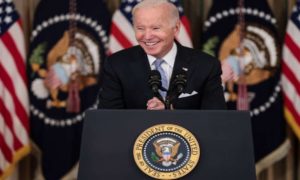President Biden’s reductionist formula has prompted a debate over whether the mayhem in Kabul was inevitable or the result of a failure to consider other options.
As the American military withdrawal from Afghanistan capping an ill-fated 20-year war turned uglier and deadlier in recent days, President Biden has stood by his decision but at the same time repeatedly singled out one person in particular to blame: his predecessor.
Because President Donald J. Trump struck an agreement with the Taliban last year to pull out, Mr. Biden has insisted that he had no choice but to abide by the deal he inherited or send tens of thousands of American troops back to Afghanistan to risk their lives in a “forever war.” It was, in other words, all in or all out.
But that reductionist formula has prompted a profound debate over whether the mayhem in Kabul, the capital, was in fact inevitable or the result of a failure to consider other options that might have ended in a different outcome. The unusual confluence of two presidents of rival parties sharing the same goal and same approach has led to second-guessing and finger-pointing that may play out for years to come in history books yet unwritten.
In framing the decision before him as either complete withdrawal or endless escalation, Mr. Biden has been telling the public that there was in fact no choice at all because he knew that Americans had long since grown disenchanted with the Afghanistan war and favored getting out. The fact that Mr. Trump was the one to leave behind a withdrawal agreement has enabled Mr. Biden to try to share responsibility.
“There was only the cold reality of either following through on the agreement to withdraw our forces or escalating the conflict and sending thousands more American troops back into combat in Afghanistan, lurching into the third decade of conflict,” Mr. Biden said as the Taliban seized Kabul this month.
Critics consider that either disingenuous or at the very least unimaginative, arguing that there were viable alternatives, even if not especially satisfying ones, that may not have ever led to outright victory but could have avoided the disaster now unfolding in Kabul and the provinces.
“The administration is presenting the choices in a way that is, at best, incomplete,” said Meghan O’Sullivan, a deputy national security adviser under President George W. Bush who oversaw earlier stages of the Afghan war. “No one I knew was advocating the return of tens of thousands of Americans into ‘open combat’ with the Taliban.”
Instead, some, including the current military leadership of Defense Secretary Lloyd J. Austin III and Gen. Mark A. Milley, the chairman of the Joint Chiefs of Staff, asserted that keeping a relatively modest force of as few as 3,000 to 4,500 troops along with the extensive use of drones and close air support could have enabled Afghan security forces to continue holding off the Taliban without putting Americans at much risk.
“There was an alternative that could have prevented further erosion and likely enabled us to roll back some of the Taliban gains in recent years,” said Gen. David H. Petraeus, the retired commander of American forces in Afghanistan and former C.I.A. director who argued the mission was making progress while serving alongside Mr. Biden under President Barack Obama.
“With the Afghans doing the fighting on the front lines and the U.S. providing assistance from the air,” he added, “such a force posture would have been quite sustainable in terms of the expenditure of blood and treasure.”
But the White House rejected such a middle ground, contending that it amounted to more war. At her briefing on Friday, Jen Psaki, the White House press secretary, said the only real choice was sending tens of thousands more Americans to “potentially lose their lives” or getting out.
“There are of course other options, but there are consequences to every option,” she said. “That is my point.” As for the critics, she said, “I think it’s easy to play back seat” driver.
Senator Christopher S. Murphy, a Democrat of Connecticut who supports Mr. Biden’s withdrawal, said those arguing to keep troops in Afghanistan were the ones who failed to win the war for two decades and perpetually pushed to stay even though “we have been losing for six to eight years.”
“To me, it’s the same game,” he said in an interview. “Everybody’s got a plan. But I’ve been working on this long enough to know everybody’s plans are” awful, he added, using an expletive. “The reality is inescapable.”
Mr. Biden was the third president in a row determined to finally end the war in Afghanistan, which has cost the lives of more than 2,400 American troops and an estimated 240,000 Afghans, and as much as $2 trillion. In recent years, though, the conflict had evolved into an uneasy status quo with a far smaller American footprint. After drawdowns beginning under Mr. Obama, just a fraction of the troops there at the peak were left, yet military strategists said they had an outsize impact in keeping Afghan security forces in the fight without engaging in as much combat themselves.
Fewer than 100 American troops died in combat in Afghanistan over the past five years, roughly the equivalent of the number of Americans currently dying from Covid-19 every two hours. Until the devastating attack this week by ISIS-K at the Kabul airport killed 13 American service members, the military had suffered no combat deaths since the Trump agreement was signed.
Under the four-page deal signed in February 2020, Mr. Trump agreed to withdraw all American troops by May 1, 2021, lift sanctions and compel the release of 5,000 prisoners held by the Afghan government, which was cut out of the negotiations. The Taliban committed to not attacking American troops on the way out or letting terrorist groups use Afghanistan as a base to attack the United States.
While the Taliban agreed to talk with the Afghan government, nothing in the publicly released part of the deal prevented it from taking over the country by force as it ultimately did and reimposing its repressive regime of torture, murder and subjugation of women. It was such a one-sided bargain that even Mr. Trump’s former national security adviser H.R. McMaster called it a “surrender agreement.”
Following the deal, Mr. Trump reduced American forces in Afghanistan to 4,500 from 13,000. Eager to be the president to end the war, he signed a memo to the Pentagon instructing it to pull out all remaining forces by Jan. 15 before leaving office, but was talked out of it by advisers. Instead, he ordered the force drawn down to 2,500 troops in his final days, although about 3,500 actually remained.
For Mr. Biden, inheriting such a small force in Afghanistan meant that commanders were already left with too few troops to respond to a renewed Taliban offensive against American forces, which he deemed certain to come if he jettisoned Mr. Trump’s agreement, requiring him to send thousands more troops back in, officials said.
While he has suggested he had little choice because of the Trump agreement, Mr. Biden in fact was already determined to pull out of Afghanistan regardless and acknowledged in a recent interview with ABC News that “I would have tried to figure out how to withdraw those troops” even if his predecessor had not negotiated a deal with the Taliban.
His views were shaped by his experience as vice president in 2009 arguing against the temporary troop surge that Mr. Obama ordered to Afghanistan. Mr. Biden emerged from that episode soured on the military and the war, convinced that the generals had rolled Mr. Obama by making it politically impossible not to go along with more troops.
Democrats who once worked with Mr. Biden said they assumed that his mind therefore was already made up on Afghanistan when he took office in January and that his current advisers, knowing that, did not push back hard. But aides to the president insisted that while he did have strong views, he engaged in a methodical policy process to test his own assumptions and explore alternatives, repeatedly insisting there be “no stone left unturned.”
Mr. Biden assigned Jake Sullivan, his national security adviser, to run an interagency examination of Afghanistan policy that resulted in 10 meetings of department deputies, three cabinet-level meetings and four meetings in the Situation Room that included the president.
The Biden team considered other options, including keeping a small presence of troops for counterterrorism operations or to support Afghan security forces, but reasoned that was just “magical thinking” and would take more troops than was sustainable. They discussed whether to renegotiate the Trump agreement to extract more concessions but the Taliban made clear it would not return to the bargaining table and considered the Trump deal binding.
Mr. Biden’s advisers also considered extending the withdrawal deadline until the winter, after the traditional fighting season was over, to make the transition less dangerous for the Afghan government. The Afghanistan Study Group, a bipartisan congressionally chartered panel that was led by Gen. Joseph F. Dunford Jr., a retired Joint Chiefs chairman and that included Ms. O’Sullivan, in February recommended extending the May 1 deadline and seeking better conditions before pulling out.
But Mr. Biden was warned by security specialists that the longer it took to withdraw after a decision was announced, the more dangerous it would become, aides said, so he extended it only until Aug. 31.
Particularly influential on Mr. Biden, aides said, were a series of intelligence assessments he requested about Afghanistan’s neighbors and near neighbors, which found that Russia and China wanted the United States to remain bogged down in Afghanistan.
At the end of the day, then, the officials said every option eventually led to one of the two ultimate alternatives — get out altogether, as Mr. Trump had agreed to do, or prepare for a prolonged and more dangerous shooting war with many more troops. While not everyone in the room preferred Mr. Biden’s path, officials maintained that everyone was heard.
“Biden basically faced the same issue that Trump faced,” said Vali Nasr, who was a senior adviser to Richard C. Holbrooke, Mr. Obama’s special representative on Afghanistan and Pakistan, “and his answer was the same — we’re not going to go back in, we have to get out.”
Republican criticism now, he added, was brazenly hypocritical. “They’re the ones who released all these Taliban commanders, they’re the ones who signed this deal,” he said.
Mark T. Esper, a defense secretary under Mr. Trump, agreed that the deal was flawed and in fact argued against drawing down further in the final months of the last administration before being fired in November. In recent days, he said, “there were more options available to President Biden” than simply continuing Mr. Trump’s withdrawal.
“He could have tried to go back to the table with the Taliban and renegotiate,” Mr. Esper said on CNN. “He could have demanded, as I argued, that they agree to the conditions they established or they agreed to in the agreement and that we use military power to compel them to do that.”
At this point, the die is cast. Mr. Biden made his choice. He wanted to be the president to end America’s longest war. Right or wrong, he has done so and on that, there is no middle ground.





















